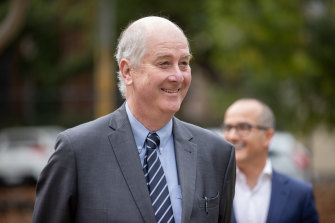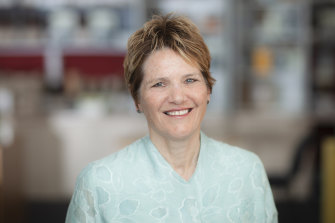Key points
- The Andrews government has found money in the budget to fund the From Homelessness to a Home program for a further 12 months.
- The program provides housing and support for people, and has been described as “world’s best practice” by the homelessness sector.
Funding has been reinstated for a Victorian program introduced during the pandemic to provide shelter for rough sleepers that has been described as world’s best practice for solving homelessness.
The sector last month sounded alarm bells over the Andrews government’s decision to end the two-year From Homelessness to a Home program and warned the $43 million cut in the May budget could have left 1440 people without support.
Housing Minister Richard Wynne has found extra money in the budget to continue funding the From Homelessness to a Home program.Credit:Simon Schluter
Housing Minister Richard Wynne initially said rough sleepers would be supported through other initiatives, but last week he told the sector the program would be extended for a further year after the government found money in the budget.
The program has “supported more than 1750 households to move into new homes with individual, tailored support”, a Victorian government spokeswoman said in a statement. “We have identified additional funding to ensure that the program can continue support and head-leases, where required, for existing participants in 2022-23. Additional funding will ensure that people in head-leased properties can remain until suitable long-term housing is secured.”
The $150 million program was established by the state government at the beginning of the COVID-19 pandemic to house rough sleepers in hotels and provide permanent homes and support services when lockdowns ended.
People staying in hotels have been given tailored support – including mental health, drug and alcohol, and family violence assistance – which continued when they moved into long-term housing.
Council to the Homeless chief Jenny Smith hopes the program will become a permanent fixture.
There are currently 13 households living in hotels while they wait to move into new homes as part of the program.
Council to Homeless Persons chief executive Jenny Smith welcomed the government’s decision to reinstate funds until next year, and said she hoped the program would eventually become a permanent fixture.
“[The] Homelessness to a Home program was a humanitarian response in recognising that if something wasn’t done to provide a social housing pathway, and support for people with complexities to keep their housing, it would become a bigger problem,” Smith said.
“If we could grow the program, we would stop that churn from emergency departments, prisons, psych beds, general beds.
“If the funding had been cut, half the people with that type of complexity who don’t get support tend to fall out of social housing within two years and back to the start of the queue, and you’re back to emergency departments, and we’re spending hundreds of thousands of dollars sorting out health and mental health.”
One of the program’s service providers was Wintringham, the country’s largest provider to elderly homeless people in Australia.
Chief executive and founder Bryan Lipmann described From Homelessness to a Home as “brilliant” and said he was delighted the government would fund it for the next year.
“The provision of housing is insufficient to solve homelessness; you need to provide people with support,” Lipmann said. “This program, the world’s best practice, delivered the holy grail of giving people housing and support. We have clients in the program, and it will enable their continued tenancy and to be supported.”
The Morning Edition newsletter is our guide to the day’s most important and interesting stories, analysis and insights. Sign up here.
Most Viewed in Politics
From our partners
Source: Read Full Article


